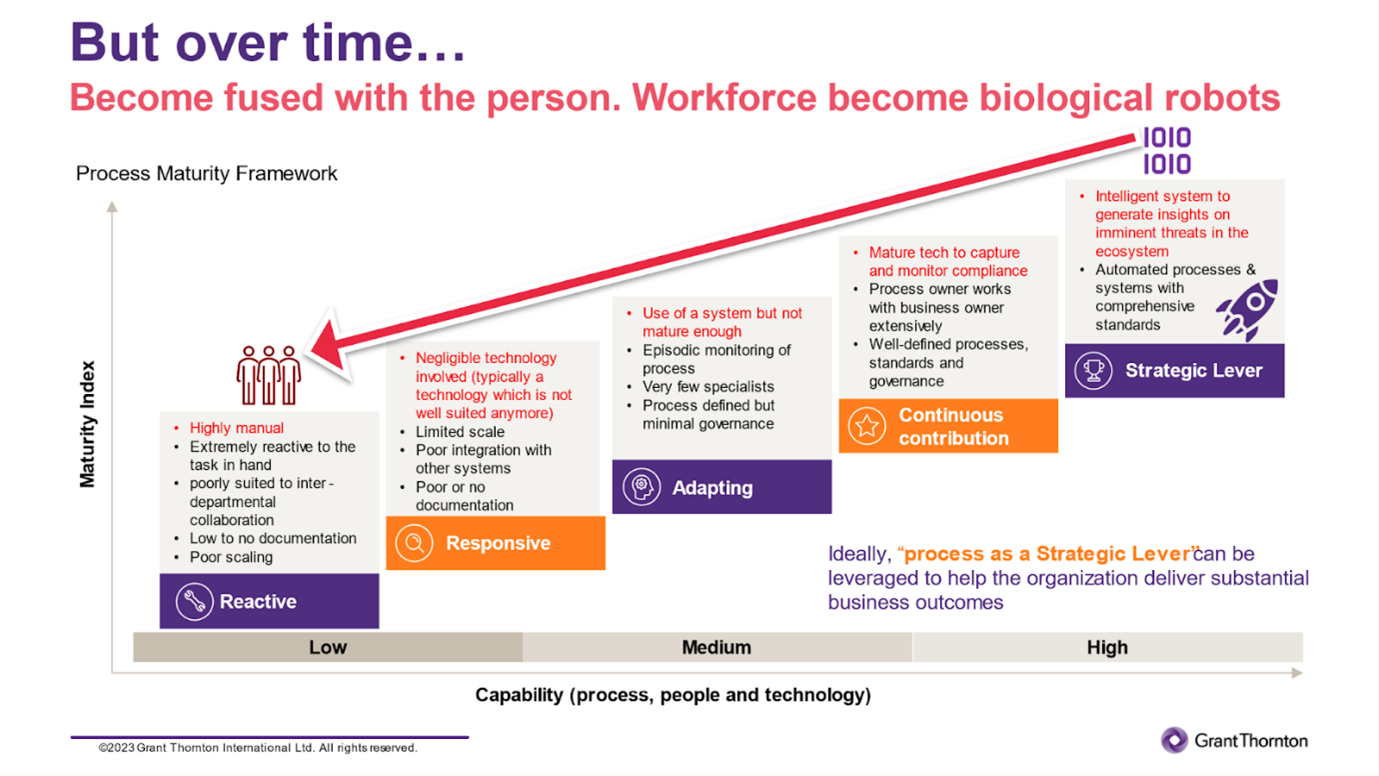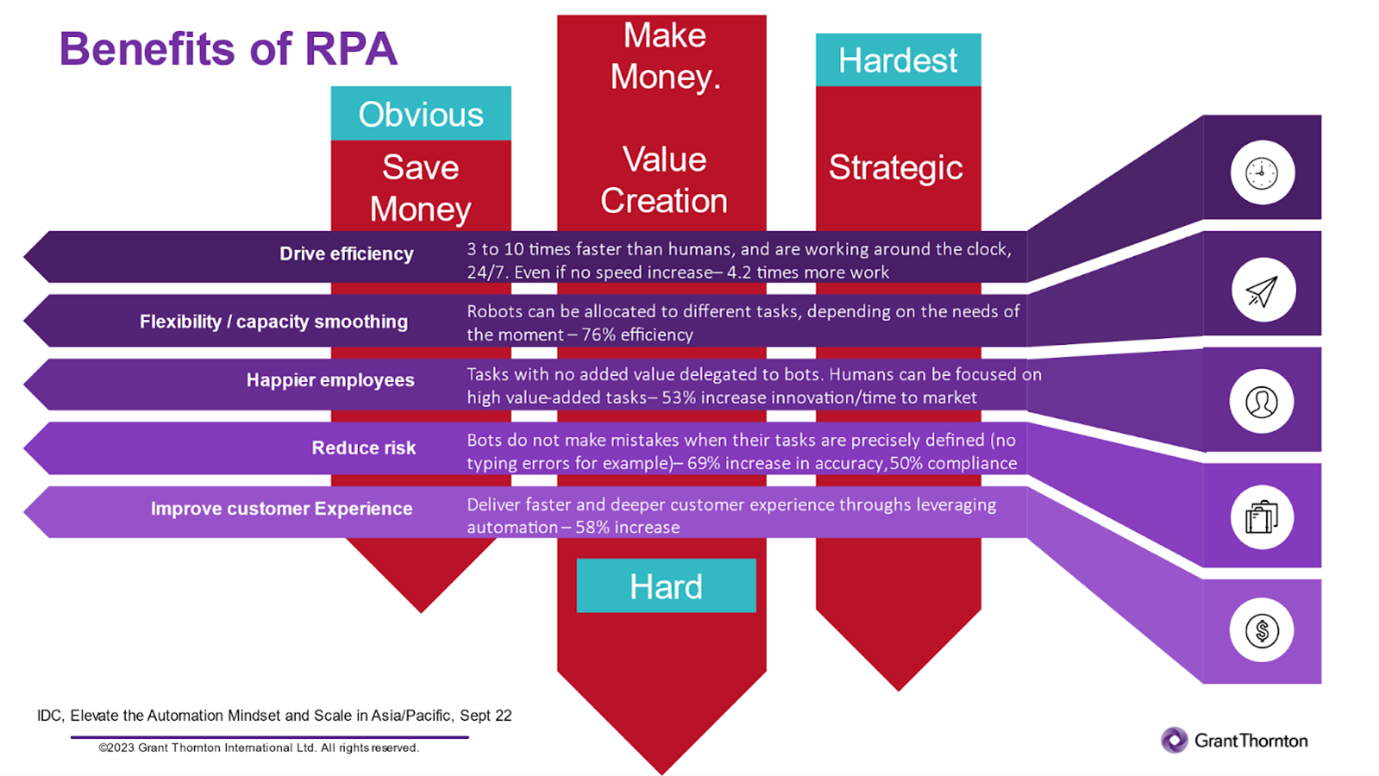
Process Optimisation in Modern Business by Andrew McBean
Though technological progress is advancing at an ever-increasing pace, global economic markets remain on shaky ground. The World Bank forecasts just 2.4% global economic growth year on year in 2024. Here in Thailand, the SET experienced a notable decline throughout 2023, falling by 15.86% over the year.
Even more troubling for the long term, Thailand is on the path to being a super-aged society with a serious skills shortage. Due to low birth rates in the kingdom, experts are now saying that if current trends continue, Thailand's population will drop to about 33 million in about six decades.
In this context, it is essential that businesses in Thailand — and their key people by extension — are focusing on the key priorities of their business: Maximising profit, driving efficiency, increasing productivity, exceeding customer expectations, delivering faster and more valuable service for customers, unlocking employee potential, building new revenue streams, and responding in a more agile way to digitally unlocked market insights.
However, at the most fundamental level of this effort, many businesses are still falling short. Without processes and procedures that are both documented and optimised, any growth is akin to building upon a fragile house of cards.
And yet, analysis by Grant Thornton in Thailand reveals that sound practices in this area are often overlooked in the corporate world in Thailand. This oversight not only limits operational efficiency but also leaves enterprises vulnerable to the loss of critical institutional knowledge.
Money is being left on the table by not taking the time to identify opportunities for automation. I guarantee you that if my team were to assess your present systems, we’d identify dozens of high value, low complexity processes in your present system that can be quickly optimised to start creating return on investment almost immediately.

The way forward can be understood through the 5 steps in the infographic above — from documenting existing processes, all the way to fully automating processes which can generate insights on imminent threats and opportunities within the ecosystem. Companies that prove adept at adaptation will find themselves at a distinct advantage moving forward.
Starting with a Foundation of Visibility
It is widely acknowledged in business and management literature that a significant portion of organisational knowledge, especially in less digitally mature companies, tends to passively reside in the minds of employees rather than in well-documented procedures.
This approach, while seemingly pragmatic, harbours significant risks. When these key people exit the organisation, they often take their expertise with them. The resultant knowledge gap can regress a business to its embryonic stages of process development, necessitating a reconstitution of these vital operational mechanisms from scratch.
Process documentation has long served as the backbone of operational clarity and consistency. It is the systematic recording of how business tasks are executed, ensuring that operational knowledge is democratically accessible, rather than being siloed within individuals. This effort has traditionally looked something like the below:
1. Inventory and analysis of all business processes
2. Detail accumulation among multiple stakeholders
3. Validation of processes to ensure accuracy
4. Documentation strategies such as SOPs and flowcharts
5. Iterative improvement via regular reviews and updates
While this approach was effective, it is laborious and time-consuming for key individuals within organisations to do this all manually. However, given that we’re talking now about digital transformation, the obvious approach is to engage in an initial digital assessment from an external, unbiased third party.
My team recently worked with an industry-leading organisation in Thailand, conducting a high level scan to identify where the organisation’s problems were coming from by capturing processes and identifying weaknesses.
From this initial assessment, we were able to identify a list of 108 areas of the business that could be directly improved with digital solutions. We were able to turn this information into a tangible, future-facing business plan including expected ROI in both financial and time-saved terms.
Companies of all types should, at minimum, increase their internal stability by documenting and refining their internal processes by the means described above. In our current age of AI, however, the potential for improvement has a much higher ceiling.
Beyond Documentation: Optimisation and Automation
Having developed a robust framework of documented processes, businesses can then pivot towards optimisation and automation. Streamlining processes by eliminating redundancies not only enhances efficiency but also paves the way for integrating advanced technologies like Robotic Process Automation (RPA).
RPA is a transformative technology that automates routine tasks by emulating human interactions with digital systems. It is particularly effective in repetitive, rule-based tasks that require minimal judgement. Its implementation requires a Process Definition Document, which essentially encodes the flow diagram for each process. From there, a Solution Design Document is designed and created, which encodes each step of the automated procedure that replaces manual completion of the task. These two documents serve as the blueprint for the successful automation of well-defined tasks, enabling the efficiency improvements that RPA then delivers.
I mentioned in the previous section how we’d identified 108 areas of business improvement. Two of these sections were the processes used for sales and accounting — major functions of any business, I’m sure you will agree. These digital upgrades have allowed the company to streamline appointment scheduling, inventory management, tracking customer orders, and analysing purchase patterns, and to improve inventory control and customer service.
RPA is a concept which has gone mainstream over recent years and is being used in all major industries. For example, in the banking sector, RPA has been instrumental in automating tasks such as customer onboarding, data validation, and fraud detection, thereby reducing manual errors and increasing efficiency.
In human resources, RPA can transform the recruitment process by automating resume screening and initial candidate communications, allowing HR professionals to focus on more nuanced aspects of talent acquisition and employee engagement.
This versatility of RPA not only demonstrates its broad applicability across industries, but also underscores its role as a key driver in the modernisation of business processes, enabling companies to achieve greater operational excellence and agility.
Yet even this level of automation does not exhaust businesses’ potential for process improvement. Far from it; recent advancements in generative AI allow software to produce genuinely creative and insightful output, streamlining processes which would have only recently required human judgement and input.

A New Formula for Improved Quality and Value Creation
Until now, we have spoken only of the type of AI that can follow precise orders. Generative AI, however, can add a healthy dose of creativity and common sense to its output — delivering human-quality content from open-ended prompts. This form of AI can complete far more advanced tasks than were possible just two years ago, such as chatting with users online, answering phone calls, writing marketing material, summarising reports, and making educated predictions about future scenarios.
The key for businesses involves learning how to think of AI not just as a replacement for low-level labour, but as a generator for true value creation within their markets. The form this takes will vary considerably from one industry to another, and indeed one company to another, but will nevertheless significantly differentiate the forward-looking businesses from those that remain stuck following tradition.
Creativity is the selling point for today’s most advanced AI software, but it will also take real creativity among its adopters to figure out how to best put this new tool to use on the essential task of value generation. From designing promising new medicinal compounds for pharmaceutical companies, to enabling self-driving vehicles and more, impactful uses of generative AI are already giving smart businesses a leg up on their competition.
Conclusion
The documentation of business processes is not merely an operational necessity but a strategic imperative. It lays the groundwork for process optimization and paves the way for the integration of innovative technologies like RPA and generative AI.
The procedures described above both safeguard institutional knowledge, and open the door for its dramatic improvement. Yet these efforts first require the establishment of a culture of efficiency, adaptability, and continuous improvement – hallmarks of a resilient and future-ready enterprise.
However, exceptional project management is required to complete transformation at this scale. Doing it in-house will inevitably require ruffling some feathers and will be a serious resource drain on your most competent people. Traditional IT vendors also struggle with these kinds of projects, as they are often unable to see the business logic of transformation, rather than making expensive changes just to be trendy.
For these reasons, we recommend working with a partner who is able to talk to you in digital transformation terms that have tangible benefits to the bottom line. Ask them how engaging in such a project will generate return on investment for you, and dig down into the specifics. When done right, digital transformation not only improves efficiency and profit margins, but allows you to create new revenue streams by genuinely transforming your business.
While incredible business transformations are now easier than ever, organisations should understand the head-winds they are likely to face. These include an ageing workforce which may prove resistant to change, on account of cultural inertia and the lack of a sense of urgency among employees to maximise their productivity using digital tools.
Employers must therefore inspire real cultural buy-in, while providing digital upskilling, when pushing for any type of process transformation. Properly executed, this combined effort will minimise the tendency of employees to revert back to a manual completion of their tasks, and move them toward a more modern standard of efficiency.
Looking for an outside, neutral perspective to support your operational improvement? At Grant Thornton, my team and I specialise in identifying strategic business transformation solutions for our clients. Get in touch for a conversation about how we can help.
If you’d like to learn more about how digital transformation can improve your business, I invite you to join a Grant Thornton workshop on the subject, led by me. These happen every quarter and provide a solid foundation for engaging in business transformation projects of all sizes.

About the Author:
Andrew McBean is a Partner in Business Consulting at Grant Thornton, with a rich background in technology and global accounting from his time at Microsoft, IBM, and other firms. His work spans across Indonesia, Japan, South Africa, and Thailand, emphasising inclusivity and cultural sensitivity. At Grant Thornton, Andrew focuses on delivering client-centric solutions, leveraging his expertise in digital transformation and process optimization. He specialises in guiding businesses through digital upgrades and efficiency improvements, helping them to harness technologies like RPA and AI to enhance their operational agility and drive growth.
Note
This article is part of an ongoing series entitled The Essential Guide to Business Transformation in 2024
To read the next article in the series, click here
To download full report, please submit form below.


Author
